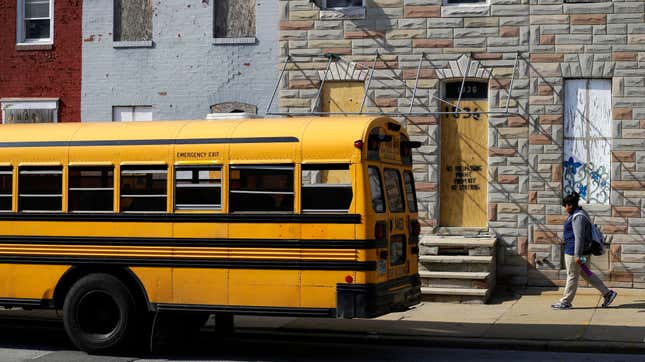
A former in-house lawyer for AT&T alleges the company systemically charged the nation’s most underfunded schools a higher rate for phone and internet service. In an interview with The Washington Post, Theodore Marcus said the telecom ignored federal E-Rate program rules, which offers schools and libraries in need of discounts on various telecommunications services anywhere from 20% to 90%.
E-Rate funds come from a small fee on everyone’s phone bill, which gets put aside and distributed to the schools and libraries that need it most. In exchange for this extra revenue, telecoms are responsible for figuring out how much money should be given to each applicant based on what similar customers pay, or the lowest corresponding price (LCP). The problem is that this is often hard to calculate because no two contracts are alike, so it can make it difficult for companies to make sure they are in compliance with the program.
But Marcus, who spent 11 years working for AT&T and was the telecom’s FCC regulator representative, alleges AT&T purposefully did not train its employees on how to calculate the LCP, which lead to false E-Rate reporting.
All of this allegedly started back in 2008 when Todd Heath, a Wisconsin consultant who helped schools figure out if they were overpaying for phone and internet services, filed a lawsuit against Wisconsin Bell, a division of AT&T. The lawsuit alleges that AT&T purposefully overcharged low-income schools from 1997 to 2009 and submitted false reports to the FCC; The Federal E-Rate program started in 1996 when just 14% of schools and libraries had internet access.
And perhaps an important side note: Marcus told the Post that when he attended a company meeting about the E-Rate program in 2008, the company gave E-Rate training documents to its employees that omitted any mention of the LCP requirements. But Fletcher Cook, a spokesman for AT&T, told the Post that the government did not provide guidance on how to comply with the E-Rate rules at the time, so it could not have ignored LCP requirements.
“We comply with the rules of the E-Rate program, and there is no evidence to support these absurd claims,” Cook said to the Post.
After the lawsuit was filed, AT&T started training its employees on how to calculate the LCP in 2009, according to Cook. Before, the telecom was using Section 202(a) of the Telecommunications Act to figure out pricing for schools and libraries under the E-Rate program. Section 202(a) has rules about discriminatory pricing, but the LCP has stricter requirements and covers internet plan pricing where the Telecommunications Act does not.
In March 2010, David B. Cohen, then Vice President of Policy at the United States Telecom Association, submitted a letter to the FCC asking for the commission to better clarify when and how the LCP price obligation should be implemented. In it he notes E-Rate rules mandate that schools and libraries who want access to E-Rate funds need to solicit pricing bids from telecom providers, and argues telecoms should only be obligated to provide LCP pricing to schools and libraries that have actually solicited bids.
“When a school or library decides to take service from a non-bidding provider based on publicly available service offerings (such as tariffs, state master contracts, or retail rates at wireless stores), that non-bidding provider often is not even aware that it has been selected to provide E-Rate service,” wrote Cohen.
A 2014 update to the E-Rate regulations clarified that if a provider is not aware a school or library should be receiving LCP pricing, then it must give that school or library LCP pricing. It’s also not necessary for a school or library to place a bid for E-Rate service under certain circumstances, such as institutions that wish to receive equipment from ISPs by entering a direct, master contract with them.
Still, Marcus believes AT&T purposefully ignored the E-Rate program rules for 13 years, but when he initially brought his concerns to the company, he said they were brushed off. However, AT&T did hire an outside firm to conduct an internal investigation in 2011, based on allegations from Detroit Public Schools auditors; AT&T overcharged the district by at least $2.8 million over five years and hundreds of thousands more in taxes when the school district was actually tax-exempt.
The outside firm found “no violation of law or attorney ethical obligations,” AT&T told the Post, but did not provide the publication with a copy of those findings.
Shortly before Marcus left AT&T in 2011, he gave those 2008 training documents to Scott Shepherd, Heath’s lawyer, since Heath’s lawsuit against the telecom in Wisconsin was still active. Later that same year, Heath filed a second suit against AT&T, but this time alleging the company ignored LCP requirements in 17 states, the District of Columbia, and two big cities. He used the training materials Marcus gave him as evidence, but ultimately the case was dismissed in 2014. Heath filed for an appeal in 2015 and that decision was reversed.
The FCC did try to fine AT&T for violating the LCP in 2016, alleging the company overcharged two Orlando, FL public school districts, but the suit was ultimately dismissed; Former FCC chairman Ajit Pai dismissed the suit, saying the government didn’t file it within the statute of limitations.
Currently, AT&T is waiting to see if a judge will dismiss that case. It claims Heath unethically obtained those training documents, documents that Marcus should not have shared while he was still employed with the company.